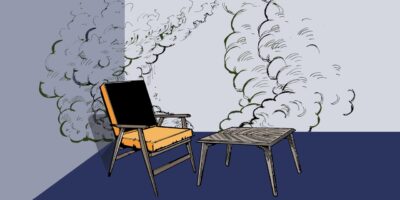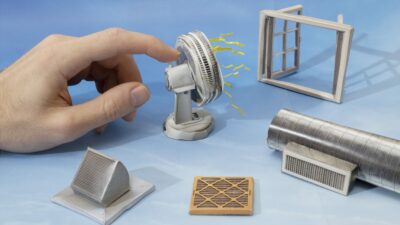
The client wasn’t super-wealthy, but she was thoughtful about her home and hands down the most eco-conscious woman Colorado interior designer Megan Thompson had ever met. The 30-something vegan was asking for Thompson’s help with two flooring projects: She wanted wall-to-wall carpeting upstairs in and around her family’s bedrooms, and she was looking to turn a small area downstairs into a yoga/meditation room, preferably with easy-to-clean, budget-friendly, wood-mimicking vinyl.
Carpet and vinyl. Thompson, who recently made a personal pledge that at least 80% percent of her projects will be 100% environmentally sustainable, saw this as a teaching moment.
“Okay, I want to tell you about some things,” she recalls telling her client, going on to carefully explain the dangers inherent in both flooring choices—primarily the health impacts of chemical inhalants. Not only would these chemicals flood a home during the installation of new carpet or vinyl planks, but they would continue to gradually leach into the air for years to come—a more subtle (but dangerous) process referred to as off-gassing. Thompson didn’t want her client’s family exposed to a vapor stew of chemicals every day, least of all in the yoga space, where the whole point was to breathe deeply while near the floor.
She offered her client some carefully sourced options such as an all-wool carpet with a natural rubber pad, and advocated for solid, sustainably sourced wood downstairs instead of a composite of plastics. “I thought she’d be excited,” Thompson says. “But because of her beliefs about animal rights, I learned that wool wasn’t acceptable to her…and there were price point issues too. I thought, ‘Wow, this is a whole new level I hadn’t encountered.’”
Welcome to what materials experts call “one of the most complicated issues in health and wellness,” the murky and unregulated (at least in the U.S.—Europe is much stricter) relationships humans have with thousands of airborne toxins emanating from our building materials, furnishings, cleaning products, car interiors, iPads, and even candles.
“Nobody’s telling you what is coming from all those vapors mixing in the air,” says Jillian Pritchard Cooke, the founder of Wellness Within Your Walls, an education consultancy focused on dramatically reducing the dangers of off-gassing in the built environment. “It’s up to us to understand the individual effects each chemical can have on your nervous system, your lungs, and your cellular makeup. We need to be doing right by our clients.”
Designers have, of course, been aware of the dangers of volatile organic compounds (VOCs) for a long time, and have helped influence some wins in the marketplace, like the rising popularity of low- or no-VOC paints and the 2015 ban Home Depot and Lowe’s instituted in 2015 on toxic phthalates (a class of industrial chemicals that help make plastic bendy) in flooring.
But the problem endures, and unfortunately, many of the worst effects of VOCs—showing up in health conditions—accumulate over long periods of time.
According to Susan Inglis, executive director of the Sustainable Furnishings Council, a coalition of industry professionals dedicated to safer, greener home furnishings, “We’re learning more now and the news is discouraging—harmful chemicals are persistent and linked directly to health problems, and we can keep using them forever! The chemical lobby is very powerful in this country and they don’t want to be regulated, that’s why. It’s just plain up to us.
So, how do you get a handle on what’s happening here, and what are the best strategies to reduce emissions that can trigger asthma, cognitive impairment, or worse? We asked that question of professional air quality assessors, experienced sustainability managers, and green-minded designers around the country, collecting their current wisdom on tools, measurement techniques, and simple tactics that can protect clients from invisible airborne poisons.
So what is off-gassing, anyway? Super simply, it’s the airborne release of a chemical, a chemical in vapor form. Whenever you smell a product, it’s off-gassing. It happens the most when a product is new. Fresh paint odor? Off-gassing. New memory-foam smell? Off-gassing. But many products or materials continue off-gassing even after the “new smell” has gone away—the fumes are just much more subtle.
What are the dangers? Chemical companies will tell you that everything off-gasses, that pineapples and roses are off-gassing. But of course, some fumes are more toxic than others, and the chemicals from plastics and adhesives tend to be the worst. Prolonged exposure can cause headaches, respiratory illnesses, hormone disruption, and a variety of cancers. Here’s a list of the worst offenders and their potential impacts.
There have been cases where toxic chemicals became so infiltrated in a building’s walls, floors, and HVAC system that a simple “airing out” couldn’t fix it. Severe air quality problems shut down an Illinois driver’s license center in 2015. Sick Building Syndrome is less common now, but airtight structures (think tall glass towers) are at higher risk than buildings with operable windows.
Who is at risk? All of us, but especially babies and school-age children, whose physiological systems are still in development. Adults with weak immune systems or respiratory problems often exhibit stronger responses to off-gassing. And any living creature who spends a lot of time near the floor (where flooring and carpets—in addition to their backings or adhesives—off-gas) is at higher risk, especially babies, toddlers, and household pets.
How do I know if the products I source off-gas? Contaminant-wary designers like Thompson in Denver and Jennifer Jones of Niche Interiors in San Francisco have spent years compiling their own personal spreadsheets of safer products (especially nontoxic adhesives and stain treatments) and vendors (especially installers) who share their off-gassing concerns. Luckily now, industry-wide databases are evolving to help. One of the most promising is Mindful Materials, a constantly updated, searchable library of more than 10,000 products with verified labeling information. It’s a nice companion to product and strategy advice at certification bodies such as GreenGuard, WELL, and the Living Building Challenge.
New products I understand, but what about antiques or vintage items? One of the best arguments for incorporating vintage pieces in design, apart from saving space in landfills and decreasing carbon emissions, is that they are far safer from an off-gassing perspective. Recycling building materials (for instance, saving the doors during a retrofit) helps too.
How do I know if my project is safe? Ravi Bajaj is a project manager at Healthy Buildings, a diagnostics firm that conducts two general kinds of air-quality tests: the chamber test (when you place an item—say, a whole couch or a laptop—in a sealed lab chamber and collect off-gassing data over hours, days, or weeks) and on-site evaluations (involving physical checks on things like air filters as well as professional air sampling over time). Most of his clients are commercial real estate firms collecting air-quality data to protect themselves from lawsuits, but knowing what he knows, Bajaj would like that to change. “Schools and homes are where we’d love to see more work done,” says Bajaj.
It’s often just a money issue: Professional assessments can cost between $2,000 and $3,000 annually.
That is expensive. Is there a low-cost option? Michelle Amt, sustainability director at VMDO architects in Charlottesville, Virginia (a firm specializing in the safe design of schools), recommends a variety of devices that can at least serve as a first sniff test, detecting any major problems in VOCs, CO2 levels, etc. She uses AWAIR monitors (tagline: “See the Invisible”) that come with an app so she can remotely collect data on her phone. Foobot and Kaiterra offer consumer-grade air sensors as well.
Bajaj and Amt warn that once you begin measuring, you may be shocked…or confused. Amt once saw VOC levels skyrocket one morning in a university classroom and found out later that someone had simply uncapped a whiteboard marker. Even fragrant body spray can activate some detectors. But they say that if you measure consistently over time, you’ll start seeing trends, good or bad.
What can I do about off-gassing going forward? Preventing toxic inhalants from entering a home, school, or office space in the first place is perhaps the first and most important off-gassing strategy for designers today. VOCs plummet when you are using solid wood instead of composite furniture, sourcing fabrics without chemical stain repellents, and making it a practice to add recycled or vintage pieces (which off-gassed long ago) to a design plan.
Jillian Pritchard Cooke suggests that designers plan ahead to slow down installs so that each new building material or piece of decor has time to shed its early fumes before occupants move in. She advocates for designers to use a warehouse or a well-ventilated porch/garage to off-gas individual items, thereby preventing a complicated mix of chemicals in the air. And she encourages interior designers to take an advisory role, encouraging clients and architects to make sure each space has plenty of fresh air intake and circulation, which can be challenging in this age of tightly sealed, energy-efficient offices and condos.
Consistently asking vendors for their most low-VOC, PVC-free product options (you’ll find innovations now in traditionally PVC-heavy products, like roller shades) is another effective strategy, according to Inglis. She’s seen the marketplace shift dramatically just because designers—even the smallest businesses—kept up the pressure on manufacturers when the government wouldn’t. All this serves to widen the scope of change even more. Amt says that when designers refuse to purchase toxic materials, the supply chain adjusts all the way back to the source, and can even help to alter dangerous factory conditions for workers outside the U.S.
“There is equity and social justice in play here too,” says Amt. “We have a voice, and industry is listening. So what will we do with it?”
Original article here


